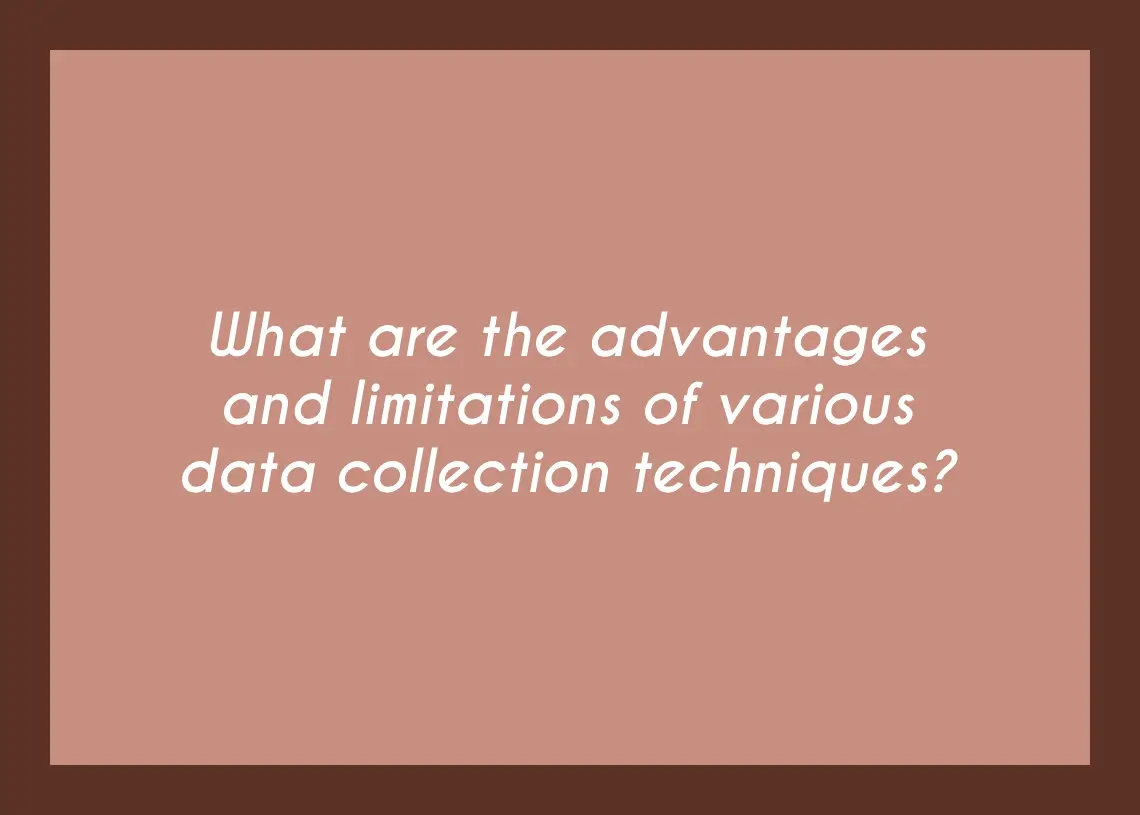In today’s data-driven world, collecting and analyzing data is becoming increasingly important for businesses and organizations looking to make informed decisions. However, different data collection techniques come with a range of advantages and limitations that should be carefully considered before deciding on the most appropriate method. This blog post will explore the various data collection techniques available, their respective advantages and limitations, and how to choose the right method for your specific needs.
Firstly, we will discuss the advantages and limitations of quantitative data collection techniques, including surveys, experiments, and observational studies. While surveys can be conducted quickly and easily, they may not always provide accurate or representative data. Experiments, on the other hand, offer greater control over the data, but can be expensive and time-consuming. Observational studies offer a more naturalistic approach, but may not allow for causal inference.
Secondly, we will delve into qualitative data collection techniques, such as interviews, focus groups, and case studies. Qualitative data can provide valuable insights into complex issues and can help researchers understand the underlying factors that influence human behavior.
Earn a certificate in your dream career for an affordable price at IAP Career College today!
Survey: Quick, inexpensive, easy setup
One of the most popular methods of data collection is conducting surveys. Surveys are quick, inexpensive, and easy to set up, making them a popular choice for many researchers. Surveys can be conducted in various forms, including online, phone, mail, or in-person.
They can target a specific population or be sent to a random sample of participants. Additionally, surveys allow researchers to collect a large amount of data in a short amount of time. However, there are also limitations to using surveys as a method of data collection.
For example, surveys rely on participants’ self-report, which may not always be accurate. Additionally, surveys may suffer from low response rates, leading to biased data. Despite these limitations, surveys remain a popular and effective method of data collection for many researchers.
Interviews: In-depth, detailed, flexible
When it comes to data collection techniques, interviews stand out as one of the most flexible and detailed methods available. Interviews allow researchers to gather in-depth information and insights directly from the participants.
This method is particularly useful when studying complex topics or when seeking to understand the participants’ perspectives or experiences. Unlike other methods, interviews are also highly flexible – they can be conducted in-person, over the phone, or via video conferencing, making them accessible to a wide range of participants.
However, it is important to note that interviews can be time-consuming and costly, and the quality of the data collected is highly dependent on the interviewer’s skills and ability to establish trust and rapport with the participants. Additionally, the data collected through interviews may be biased or influenced by the interviewer’s personal beliefs or perspectives. As such, researchers must take steps to mitigate these limitations and strive to ensure that the data collected is as accurate and representative as possible.
Focus groups: Group dynamics, interaction
Focus groups are a popular method of data collection that involves a small group of individuals who are brought together to discuss a specific topic or issue. One of the advantages of focus groups is that they provide a platform for group dynamics and interaction, allowing participants to bounce ideas off each other and build upon each other’s thoughts.
This can lead to a rich and nuanced discussion that is difficult to achieve through individual interviews or surveys. Additionally, focus groups can be a cost-effective way to gather data from multiple participants in a short amount of time.
However, there are also limitations to this method, such as potential bias or groupthink that may occur within the group dynamic. Careful consideration must be given to the selection of participants and the facilitation of the discussion to minimize these drawbacks and ensure that the data collected is accurate and representative.
Case studies: Insightful, in-depth analysis
Case studies are a powerful data collection technique that provides an in-depth analysis of a particular topic or phenomenon. They involve a detailed examination of a single case or a small group of cases to uncover the underlying causes, effects, and interrelationships that influence the outcome.
Case studies offer a more comprehensive and nuanced understanding of a particular issue, as they allow researchers to examine complex interactions between variables in real-world contexts. They are particularly useful when investigating rare or unique phenomena, or when seeking to understand the intricacies of a particular case.
Case studies can provide rich and detailed data that can be used to develop new theories, generate hypotheses, or identify areas for further research. However, one of the limitations of case studies is that they may not be generalizable to other contexts, as they rely on a single or a small number of cases.
Additionally, case studies may be subject to researcher bias, as the researcher’s perspective and interpretation may influence the findings. Despite these limitations, case studies remain a valuable data collection technique for researchers seeking to gain a deeper understanding of complex phenomena.
Observation: Unbiased, natural behavior
Observation is a data collection technique that involves recording natural behavior in an unbiased manner. This technique has several advantages, including providing a rich source of data that captures real-world behavior and interactions.
Observations can also be conducted in natural settings, which allows researchers to observe behavior as it occurs without interrupting the subject’s normal routine. Additionally, observation can provide insight into non-verbal communication and other factors that may be missed in other forms of data collection. However, there are also limitations to this technique.
Observations can be time-consuming and require a high level of skill to accurately record and interpret behavior. Furthermore, participants may alter their behavior if they are aware they are being observed, leading to potential observer bias. Despite these limitations, observation remains a useful tool for researchers seeking to understand natural behavior in a variety of settings.
Experiments: Control over variables
Experiments, particularly those with control over variables, offer a high degree of accuracy and precision in data collection. By manipulating and controlling different variables, researchers can isolate and test specific factors that may have an impact on the outcome.
This approach allows for the establishment of cause-and-effect relationships and can provide insights into how certain variables interact with one another. Additionally, experiments can be replicated with similar conditions to validate the initial findings, increasing the reliability of the data collected.
However, there are also limitations to this approach, such as the need for a controlled environment, which may not accurately reflect real-world situations. Moreover, it may be difficult to control all variables, particularly those outside the laboratory setting. Overall, experiments with control over variables offer a powerful tool for data collection, but researchers must also consider their limitations and potential biases.
Secondary data: Time and cost-efficient
Secondary data is an important data collection technique that involves using data that has already been collected and analyzed by someone else. This method is time and cost-efficient since the data is readily available and does not require any additional resources to collect.
Secondary data can be obtained from various sources such as government reports, academic journals, and online databases. One of the advantages of using secondary data is that it can provide a broad perspective on a particular topic or issue, as it has been collected from a variety of sources.
Additionally, secondary data is often reliable and of high quality, as it has been previously vetted and analyzed. However, it is important to note that secondary data may not always be relevant or up-to-date, and there may be limitations to its use. Overall, secondary data is a valuable data collection technique that can save time and resources while providing valuable insights into a particular subject.
Social media analysis: Real-time feedback, wide reach
Social media analysis is a popular data collection technique that offers several advantages for businesses and organizations. One of the most significant benefits is the ability to receive real-time feedback from customers or followers. Social media platforms allow users to share their thoughts, opinions, and experiences instantly, providing businesses with immediate insights into customer sentiment and preferences.
Additionally, social media analysis offers a wide reach, allowing businesses to collect data from a vast and diverse audience. This can be particularly useful for identifying trends and patterns across different demographics, which can inform marketing strategies and product development.
However, it’s essential to note that social media analysis also has limitations. The data collected is often unstructured and may require significant effort to analyze effectively. Plus, social media users may not always represent the broader population, and the platform’s algorithms can affect the data collected. Overall, social media analysis can be a valuable tool when used in conjunction with other data collection techniques.
Big data analysis: Large volumes of data
Big data analysis is a powerful technique that enables organizations to gain valuable insights from large volumes of data. With the exponential growth of data, there is an increasing demand for big data analysis. This technique provides a way to analyze and extract insights from unstructured data, such as social media feeds, customer reviews, and sensor data.
Big data analysis has the potential to transform businesses by providing real-time insights and enabling data-driven decision-making. However, there are limitations associated with big data analysis, such as the need for specialized skills and tools to process and analyze large volumes of data. Additionally, there are concerns about data privacy and security, as large volumes of data may contain sensitive information.
It is important for organizations to carefully consider the advantages and limitations of various data collection techniques, including big data analysis, to select the most appropriate technique for their needs.
Data triangulation: Enhanced credibility, reliability
Data triangulation is a powerful technique used in research and data analysis that involves cross-referencing multiple sources of data to enhance credibility and reliability. By utilizing different data sources and methods, researchers can validate their findings and eliminate the biases that may arise from relying on a single source of information.
The process of data triangulation involves comparing and contrasting data from different sources, such as interviews, surveys, and observations, to identify patterns, discrepancies, or inconsistencies that may arise. This approach can help researchers to identify and address any gaps in their data, increase the accuracy of their findings, and improve the overall quality of their research.
However, it is worth noting that data triangulation can also be time-consuming and resource-intensive, and may require a significant amount of skill and expertise to execute effectively.
Conclusion: What are the advantages and limitations of various data collection techniques?
In conclusion, selecting the appropriate data collection technique is crucial for obtaining accurate and reliable data. Each technique has its own set of advantages and limitations. Therefore, researchers must carefully evaluate the nature of their research question, the available resources, and the characteristics of their sample population before selecting a data collection technique.
Combining multiple techniques and triangulating the results can also enhance the validity and reliability of the data. In summary, choosing the right data collection technique is essential for conducting successful research and making informed decisions.




